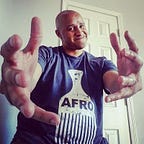Scrum + Hip Hop: Vol. 5
Stand Up & Be Heard
The stand-up. Some folks call it the daily scrum. Whatever you call it, it’s when your team talks about what they’re working on, and what’s standing in their way. It’s like getting your hip hop crew together to spit the rhymes that’ve been tumbling around in their heads for a song in progress. No matter what you call it, the stand-up is all about communication, and the next three questions should sound familiar:
- What did you work on yesterday?
- What will you be working on today?
- What impediments are in your way?
When communication is flowing, stand-ups should sound something like this:
“I wrote rhymes for the first verse yesterday. I’ve got an idea for my next part that I’ll work on today, but I can’t come up with a hook.” — MC Jr. Developer
“Why don’t you work with DJ QA, or MC Sr. Developer today? They’re good at coming up with dope hooks.” — Scrum Master
“We goin’ worldwide, across the nation. Now that we’ve activated our communication.” — The Black Eyed Peas
In Scrum + Hip Hop: Vol. 3, I talked about alarm bells that might be going off (like adding more sprints because stories didn’t get completed, or a borked burndown chart). Another alarm to keep your ears perked up for is when your stand-ups come off like status meetings.
It’s an easy trap to fall into, especially when coming off of Waterfall. Developers are so accustomed to working individually, and the natural tendency is to treat the scrum master like a project manager, whose responsibility includes doling out work assignments, and tracking progress. What can happen is rather than address the entire team, people new to Scrum will lock eyes with the scrum master during stand-ups. After answering the three questions, it’s like they’re seeking acknowledgement in the form of a head nod, a thumb’s up, or an “OK.” Or worse, developers spout endless streams of technobabble.
I’ll be the first to admit, I fell victim to these tendencies myself. When I first started off, I didn’t know jack about what it meant to be a successful scrum master. My department threw us into a 2-day training session, and expected that to be sufficient. What they didn’t understand (myself included) is how fundamentally different work is completed in Scrum. It’s a team sport.
“Not a problem my squad can’t fix. Cause we can do, it in the mix.” — Busta Rhymes
When teams come together like Voltron, everyone’s working toward the same goal. It’s only then when the three stand-up questions start to make sense. The first two (“What did you work on yesterday?” and “What will you be working on today?”) are directed at your crew. If everyone’s working on something different, these questions have little relevance. These questions are meant to let you team know how far along you are with your part.
The last question, “What impediments are in your way?” can be directed at either your team, or the scrum master. If something like “Which branch in GitHub should I commit this code?” comes up, it can be handled on the team level. If a pesky project manager keeps asking developers to squeeze a bug (or ten) into a sprint, that’s an impediment that the scrum master should lock down. This question calls out what’s in the way, and who’s in a position to remove it.
Stand-ups are like daily check points that help you figure out if your crew is on track, or flying off the rails. This is where you make micro-adjustments as needed, remove impediments, and react to changes. And isn’t that the whole point of Agile?
The Next Track: Don’t Let Heroes Hold It Down
